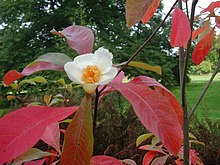
A glacial relict is a population of a species that was common in the Northern Hemisphere prior to the onset of glaciation in the late Tertiary that was forced by climate change to retreat into refugia when continental ice sheets advanced.[1] They are typically cold-adapted species with a distribution restricted to regions and microhabitats that allow them to survive despite climatic changes.[1][2]
- ^ a b Dítě, Daniel; Hájek, Michal; Svitková, Ivana; Košuthová, Alica; Šoltés, Rudolf; Kliment, Ján (September 2018). "Glacial-relict symptoms in the Western Carpathian flora". Folia Geobotanica. 53 (3): 277–300. doi:10.1007/s12224-018-9321-8.
- ^ Jiménez-Alfaro, Borja; García-Calvo, Laura; García, Pedro; Acebes, José Luis (2016). "Anticipating extinctions of glacial relict populations in mountain refugia". Biological Conservation. 201: 243–251. doi:10.1016/j.biocon.2016.07.015.